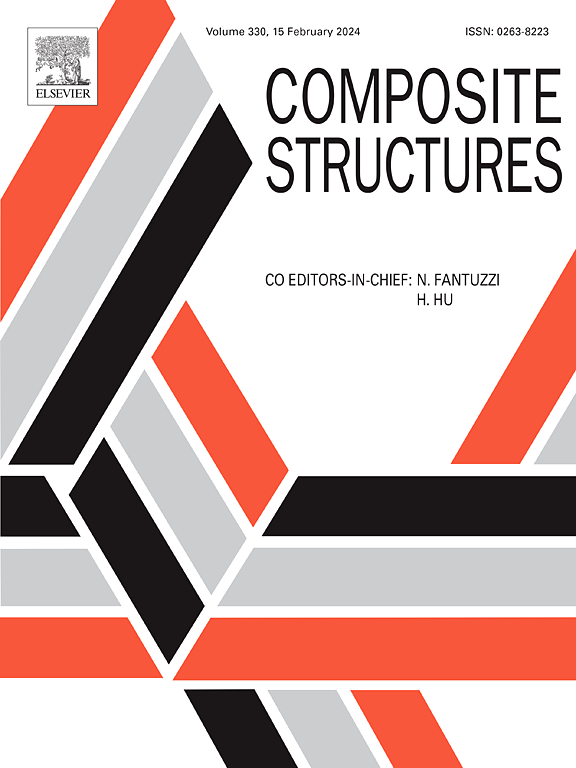Quasi-static compression and impact resistances of novel re-entrant chiral hybrid honeycomb structures
IF 6.3
2区 材料科学
Q1 MATERIALS SCIENCE, COMPOSITES
引用次数: 0
Abstract
Negative Poisson’s ratio metamaterials have excellent energy absorption performance and have been widely used in impact protection structures. The re-entrant hexagonal honeycomb (TRH) is one typical and widely used metamaterial. However, the TRH has drawbacks of insufficient stiffness and unstable deformation. This paper combines the traditional re-entrant cell with a chiral cell to form re-entrant chiral hybrid cells (RCEs) to further improve the mechanical properties of TRH. By arranging the intercellular connectors and RCEs with different patterns, four novel negative Poisson’s ratio honeycomb structures (RCH-1, RCH-2, RCH-3 and RCH-4) are proposed. The in-plane quasi-static compression characteristic of TRH and RCH-4 are investigated through experiments and simulations. Effects of the honeycomb type, the cell wall’s thickness, the chiral ring’s radius, the impact direction and velocity on impact resistance are evaluated. It’s found that the introduction of chiral ring not only has a supportive effect on the inclined cell walls also enhances the deformation stability and load-bearing capacity of RCEs. Reducing the radius of chiral ring within a certain range can enhance the impact resistance of the proposed honeycomb structures. Properly increasing the cell wall’s thickness can improve the impact resistance of honeycomb structures. It is observed that the RCH-4 has the highest plateau stress, elastic modulus, specific energy absorption and the most stable deformation pattern under vertical impact. In the case of lateral impact, the RCH-2 has the highest specific energy absorption. At different impact velocities, the specific energy absorptions of the proposed honeycomb structures are higher than that of TRH.
新型可重入手性杂化蜂窝结构的准静态压缩和抗冲击性能
负泊松比材料具有优异的吸能性能,在冲击防护结构中得到了广泛的应用。重入式六方蜂窝(TRH)是一种典型且应用广泛的超材料。但TRH存在刚度不足、变形不稳定等缺点。本文将传统的可重入性电池与手性电池相结合,形成可重入性手性杂交电池(rce),进一步提高TRH的力学性能。通过对蜂窝间连接器和rce的不同排列方式,提出了4种新型负泊松比蜂窝结构(RCH-1、RCH-2、RCH-3和RCH-4)。通过实验和仿真研究了TRH和RCH-4的面内准静态压缩特性。考察了蜂窝类型、蜂窝壁厚度、手性环半径、冲击方向和速度等因素对抗冲击性能的影响。研究发现,手性环的引入不仅对倾斜的细胞壁有支撑作用,而且增强了rce的变形稳定性和承载能力。在一定范围内减小手性环半径可以提高蜂窝结构的抗冲击性能。适当增加蜂窝壁厚度可以提高蜂窝结构的抗冲击性能。观察到,RCH-4在垂直冲击下具有最高的高原应力、弹性模量、比能吸收和最稳定的变形模式。在侧向碰撞情况下,RCH-2的比能吸收最高。在不同的冲击速度下,蜂窝结构的比能吸收均高于TRH结构。
本文章由计算机程序翻译,如有差异,请以英文原文为准。
求助全文
约1分钟内获得全文
求助全文
来源期刊

Composite Structures
工程技术-材料科学:复合
CiteScore
12.00
自引率
12.70%
发文量
1246
审稿时长
78 days
期刊介绍:
The past few decades have seen outstanding advances in the use of composite materials in structural applications. There can be little doubt that, within engineering circles, composites have revolutionised traditional design concepts and made possible an unparalleled range of new and exciting possibilities as viable materials for construction. Composite Structures, an International Journal, disseminates knowledge between users, manufacturers, designers and researchers involved in structures or structural components manufactured using composite materials.
The journal publishes papers which contribute to knowledge in the use of composite materials in engineering structures. Papers deal with design, research and development studies, experimental investigations, theoretical analysis and fabrication techniques relevant to the application of composites in load-bearing components for assemblies, ranging from individual components such as plates and shells to complete composite structures.
 求助内容:
求助内容: 应助结果提醒方式:
应助结果提醒方式:


